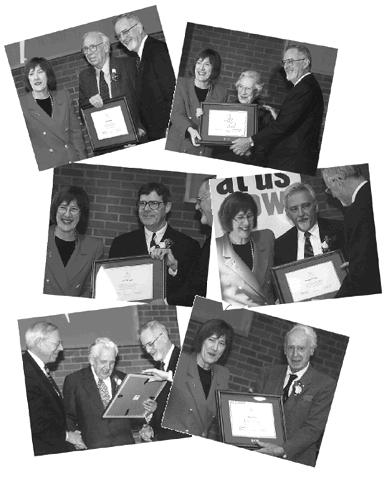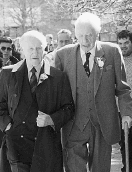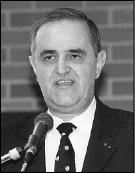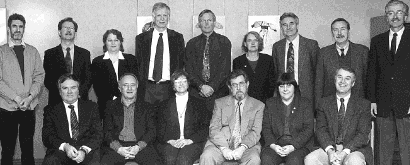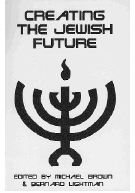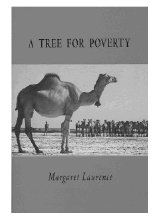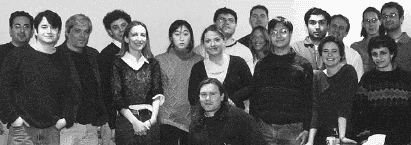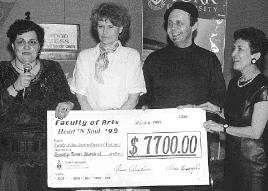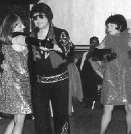
|

|
|
|
|
| | VOLUME 29, NUMBER 29 | WEDNESDAY, APRIL 21, 1999 | ISSN 1199-5246 | | |
|
|
||
|
|
For 70 years the CIIA has provided a non-partisan, nation-wide forum for informed discussion, analysis and debate of international affairs, foreign policy and global issues from a Canadian perspective. With branches from Victoria to Halifax, including York University, and a head office in Toronto, the CIIA maintains a library, organizes the National Foreign Policy Conference as well as numerous symposia and speaking events annually, and publishes a scholarly quarterly, The International Journal, an international affairs magazine, Behind the Headlines and, with Irwin Publishing, the Contemporary Affairs series of foreign policy monographs. McDougall succeeds Alan Sullivan, who served as president for four years, and under whom the CIIA conducted a successful program of revitalization. Sullivan, a distinguished former Canadian diplomat, is retiring, but will continue to advise the CIIA and contribute to its activities. McDougall has held a number of senior ministerial posts in the federal government, including Secretary of State for External Affairs, Minister of Employment and Immigration and Minister of State for Finance. Associated with a number of high-level international consultative and advisory bodies, including the Washington-based Inter-American Dialogue, the International Drisis Group in London, and the Council on Foreign Relations in New York, McDougall brings to the CIIA a wide-ranging network of linkages to related organizations around the world. Following her retirement from politics in 1993, McDougall resumed her career in the business community. She will continue to serve as Chair of the Board of Trustees of the Morguard Real Estate Investment Trust, as Director of AT&T Canada, the Corel Corporation and the Independent Order of Foresters. She is a governor of York University, Chair of the Japan Society, a director of the Canadian Opera Company and the Council for Canadian Unity. In 1998 she was the chair of the Patron's Council for the 50th anniversary of the Toronto Association for Community Living, an organization dedicated to the well-being of the developmentally handicapped. "Barbara McDougall is uniquely qualified to lead the CIIA into the next century," said Alan Broadbent, chairman of the board of directors of the CIIA. "I am very pleased to accept this appointment at a time of such exceptional challenge and opportunity for Canada in the international arena," said McDougall. "I look forward to working closely with government, business, the academic community and non-governmental organizations to stimulate public interest and debate on a wide range of international issues. The CIIA has established throughout its history a reputation for excellence which is the foundation for a bright future."
|
|
|
|
War in Yugoslavia Impacts York's Serbian Students By Andrew McRae The chaos and bloodshed in Serbia by freedom fighters of the Kosovo Liberation Army (KLA), Serb paramilitaries and NATO bombardments from the air has led to a demand for hostilities to cease by the Serbian Students Association (SSA) at York University. "This madness must stop," one student proclaimed at a low-key protest in Vari Hall organized by Serbian students one day after NATO warplanes and naval ships began their campaign to "destroy and degrade" President Slobidan Milosovich's capacity to ethnically cleanse the region of Kosovo in southern Serbia. Irene Cerovina, social coodinator of the SSA opposes Canada's contributing role in the attack on Serbia: "Our taxes are being used to bomb our relatives...there are civilians at stake," and blames Western "media propaganda" for demonizing Serb forces in Kosovo. Nevertheless, she, together with other Serb students, firmly oppose Milosovich, citing that he must not be trusted, as his long history of belligerence illustrates. While the SSA's opposition to Milosovich's oligarchy is clear, their allegiance is ambivalent. Cerovina is reluctant to call the mass exodus of ethnic Albanians from Kosovo "ethnic cleansing", and believes the United States is "supporting" Albania and the KLA. Whether the US is secretly arming the KLA in order to improve their ability to protect the few Kosovars left in the regions and resist the onslaught of Serb paramilitaries is unconfirmed. What is clear, however, is that a fortnight after the first bombs fell, Macedonia, Albania and Monte Negro are choking under the pressure of floods of Kosovar refugees. Scenes of trains packed with refugees being deported out of Kosovo spark memories of similar scenes almost 60 years ago. Not to call this humanitarian crises a "cleansing" of Kosovo may seem misguided. Wherever allegiances may lie, the SSA is keen to see the violence end. Cerovina believes that if NATO does not cease its campaign, and opts to introduce ground forces into the region, the war will escalate into a "Vietnam in the heart of Europe," adding, "If I were Milosovich, I would ask the bombing to stop." This seems increasingly unlikely, as Belgrade is making little sign of capitulating. Both the Serbian and Albanian communities at York University can only wait and hope for a lasting peace deal; one that will cease hostilities by NATO, re-locate the refugees back to their homes in Kosovo and save face for Serbia.
|
|
|
|
By Beverley Else The week of March 22, 1999, York was a hive of activity as the University prepared for its 40th anniversary launch on Friday, March 26. Most members of the York community had been hearing and reading about the upcoming celebrations for weeks, but on March 25 the Greater Toronto Area became aware of this milestone anniversary, as banners were hung along streets surrounding the University's three campuses. The same day, The Toronto Star carried a special eight-page section retelling the story of York's remarkable growth to become the third largest university in Canada, with a considerable international reputation for excellence in teaching and scholarship. That night there was a celebration at the Senate meeting and the first of the memberships in the newly created Founders' Society was presented to former York Vice-president Bill Small. Details of these activities can be found in the April 14 issue of Gazette. The first group of members were inducted into the Founder's Society by President Marsden and Chancellor Bennett.
CLOCKWISE FROM UPPER LEFT: Gazette also recounted the opening ceremonies of the anniversary launch, the unveiling of the 40th anniversary banner, in Vari Hall and the flag raising in The Common. Following the official opening, the celebrations and the celebrants moved on to Founders College Dining Hall, where they could greet and reminisce with old friends over coffee and anniversary cake, get a close look at some historical mementos and photographs of the University in its early years, and have the opportunity to purchase 40th anniversary memorabilia.
President Lorna Marsden and Chancellor Avie Bennett took this opportunity to thank and honour six individuals, who were instrumental in the founding of York, with memberships in the York University Founders' Society (photos above), calling this group "The Origin of the Species". Indeed the weight in prestige, experience and years of the dignitaries on the Founders stage that day, was almost overwhelming, leading Master of Ceremonies Professor Joe Green (Theatre) to remark that he thought he was "having a senior moment". Norman Endler, distinguished research professor of psychology, who had just been inducted into the Founders Society, spoke on behalf of its other members.
Calling this a singular honour, Endler encouraged the assembly not to forget the University's roots. "History," he said, "gives us context to plan for the future. It enriches us." He spoke of the first classes, early student activism and faculty-student relations, and reminded everyone that York has always been an innovative place. Looking to the future, Endler encouraged theYork community to continue this tradition of innovation. "Let us soar with the eagles," he exclaimed. "Let others run with the turkeys." Alain Baudot (left), professor of humanities (French) brought greetings from Glendon College, York's first college. He recalled, "At the end of Glendon's first year, an editorial appeared in The Globe and Mail stating in bold letters: 'Glendon: A Failed Experiment!' Coming myself from two institutions (the Sorbonne and Cambridge) which took several hundred years to establish a modicum of reputation, I felt it was unfair to judge the failure or success...of any experiment after only one year of operation. In any case, more than three decades later, Glendon is alive and well....It remains a thriving, vibrant community of scholars and students." The same sentiments are echoed vervently for York University as a whole.
|
|
|
|
by Andrew McRae York's luncheon for faculty members celebrating 25 years at the University was held on March 11, 1999 at the Faculty Club. Shown here are (seated left to right) Paul Wilkinson (Environmental Studies [FES]), Ronald Singer (Theatre), Jill Courtney (Theatre), Howard Daugherty (FES), Carol Ohlers (Scott Library, Bibliographic Services) and Robert MacDonald (FES). Standing (left to right) are David Cooke (Glendon English), John Crozier (Glendon Psychology), Rebecca Peterson (FES), James Alcock (Glendon Psychology), Timothy Moore (Glendon Psychology), Patricia Stamp (Social Sciences and Master Founders College), Rober bain (Physical Education), John Miller (Physics) and Eric Willis (Physical Education and Master of Stong College).
Attending but not pictured was: George Tourlakis (Computer Science). Twenty-five year faculty unable to attend the luncheon were: Gene Desfor (FES), Paul Grayson (Sociaology), Judith Adler Hellman (Psychology), Richard Pope (Languages Literatures and Linguistics), Peter Roosen-Ruge (Computer Science), Neil Smith (Physical Education), Dennis Stynes (Chemistry), and Peter Such (Humanities). |
|
|
|
by Don Evans
Creating the Jewish Future is the title of a volume of essays edited by Professors Michael Brown (Centre for Jewish Studies) and Bernard Lightman (Humanities), recently published by AltaMira Press and available in the York University Bookstore. The book grew out of an October 1996 conference titled "Creating the Jewish Future." The conference, held at the Centre for Jewish Studies, attracted scholars from Europe, Israel, Canada and the United States, who addressed such themes as: faith and religion in a "secular" age, the centrality of Israel in the Jewish world, the future of Jewish cultures in the Diaspora, and changing gender expectations and roles in Jewish communal life. Following is an excerpt from Brown's introduction to the volume, used with permission. "Continuity" has become the buzzword of North American Jews in the 1990s. The word reflects the fin-de-siècle angst regarding health and future viability that has gripped the Jewish community at the approach of the new millenium. Some years ago Simon Rawidowicz noted that Jews were "the ever-dying people," throughout their long history living on the brink of extinction and in fear of it. But, in fact, the present concern about survival represents a sudden and rather surprising reversal of attitude. It is especially surprising in North America, where forward-looking optimism has long been a hallmark both of the Jewish community and of society in general. Only a few years ago none but the professional doomsayers doubted that North American Jewry would endure, and analysts such as Charles Silberman were predicting that the best of times was yet to come. Since the end of World War II, the community had enjoyed unprecedented well-being. Abroad, the Jewish people, having suffered the loss of one-third of its numbers during the Holocaust, underwent a national renaissance in the new state of Israel. This rebirth in the national centre seemed to energize Jewish life everywhere, including Canada and the United States. At the same time, for reasons largely unrelated to Israel, Jews at home in North America entered what seemed like a golden age. The signs were unmistakable: the decline of antisemitism and Jews' consequent full integration into the political, social, and economic life of the United States and Canada; the flowering of Jewish institutions now housed in grand new buildings; the emergence of North America as a major centre of Jewish learning and theology with world-class scholars and thinkers to be found not only in seminaries and yeshivot, but also in public and private universities across the continent; and finally, the superior level of academic achievement, the high social status, and the personal affluence of most members of the community. The good fortune of North American Jews and Judaism paralleled the postwar prosperity of Canada and the United States. By the 1990s, however, the winds of change were blowing across the continent. Despite the end of the Cold War and the collapse of communism, Canadians and, more acutely, Americans became afflicted with an unusual measure of self-doubt and concern for the future. This uneasiness was sparked, at least in part, by the unsuccessful Viet-Nam War abroad. It grew along with the violence and the seemingly intractable social and economic problems in the cities of the United States in particular. It was accompanied by shifts in the economy which threatened the present livelihood of many in the middle class and the future of their children. And it was marked by the eclipse of many of the values by which North Americans had long defined themselves. As one might expect, Jews have shared in the general fear that the salad days of North America were beginning to wilt. But in addition to the collective unease, Jews have a number of newfound causes for anxiety particular to their own group. Considerable anecdotal information now confirmed by scholarly research has revealed an unexpectedly large number of defections from the community - largely through intermarriage - sine the 1970s. Attrition has been accentuated by an exceptionally low birth rate. The worry over numbers is natural for a small people, and it has been heightened by the realization that a downsized community will be less able to provide the range of services to which Jews have become accustomed. A smaller community will be more vulnerable politically with regard to both domestic and foreign (chiefly Israeli) issues about which it is concerned. More serious even than the problems resulting from demographic shifts has been the loss of intellectual and spiritual vigor which the community has been experiencing, despite an unforeseen revival of traditionalism and an increasing number of people engaged in the study of Judaism. Perhaps masked earlier by enthusiasm for Israel and the activities required to ensure its viability, the erosion of many beliefs and practices that had long sustained Jewish life now began to manifest itself. Aggravating these difficulties has been the perception that Jewish social, religious and educational institutions are inadequate to the new and difficult challenges posed by North American society at the end of the twentieth century. Particularly forceful criticism has come from feminists, some of whom question [the] commitment of what they perceive to be a patriarchal, sexist tradition. That success, to a degree, underlies the community's concerns presenting no small irony but offering no great comfort. The decline of antisemitism in North America and Jews' acceptance by their neighbors have made assimilation a possibility for the many, not just the wealthy few. At the same time, one of the most important hedges against assimilation in the post-World War II era - Diaspora Jewry's involvement with the state of Israel - has been weakened. Israel's growing military security, as well as its emerging cultural independence, have distanced its citizens from Diaspora Jews and diminished the role of the latter as defenders of the state. Together these developments have contributed to the rapid mood swing of the North American Jewish community from almost unbridled optimism to gloomy pessimism. Collectively and individually, Jews have begun to question seriously their long-term future in North America and elsewhere in the Diaspora - their "continuity." A new phenomenon, which we might call "continuity anxiety," has now replaced the heady confidence of previous decades. Jewish leaders have responded by putting continuity at the top of the communal agenda. There remain, however, considerable confusion and disagreement not only about the appropriate responses to the crisis, but even about its dimensions and nature. There is disagreement, for example, about whether the intense focus of Diaspora Jewry on Israel contributes to the weakness of the North American community or offers a potential solution to its problems. And while there seems to be near unanimity regarding the vital role of education in guaranteeing continuity, many Jewish communities across the continent have actually decreased their annual educational expenditures since 1989. In pursuit of both definitions and responses, Bernard Ghert, one of Toronto's most experienced and thoughtful Jewish leaders, himself a former university teacher, decided to sponsor a conference on continuity in which academics, lay and professional communal and religious activists, and interested individuals from the community would attempt to outline the problems clearly and begin to think constructively about solving them. Echoing the words of Barry Shrage, a Boston Jewish community leader, Ghert asserted his desire to transform what seemed like an increasingly "fruitless debate about 'Jewish continuity' into a discussion concerning the shape of [the] ... Jewish future and the purpose of Jewish existence." It was thought that a conference held in Toronto might have a special contribution to make to the continuity issue. The reason has to do with the differences between Canada and the United States. To a considerable extent the two Jewries are part of the same continental community. ... Canada, however, has a Jewish population of about 350,000, while that of the United States is between five and six million. Because of its size, the Canadian community is more manageable and more cohesive than the American. Canada's Jewry is "closer to the boat" with a much higher percentage of first- and second-generation members. It has more Yiddish speakers, proportionately more Orthodox Jews, many more children in Jewish all-day schools, a lower intermarriage rate, and a stronger Zionist movement. Many of these differences can be attributed to the particular history and political and social dynamics of the country at large, to its binational make-up and its rather conservative character, and, more recently, to its multicultural ethos. For Jews (and other "ethnics"), these characteristics have resulted in much more gradual and hesitant acculturation and integration into the life of the country than has occurred south of the border and much greater communal solidarity. Some of the Canadian "lessons" regarding assimilation are clearly not applicable to other countries. But some of Canadian Jews' successful experiences can be instructive for others; and Canadians can learn from the more radical and rapid developments in the United States. There were also good reasons for choosing the Centre for Jewish Studies at York University as conference host. Like many of its sister institutions, York is dedicated to the pursuit of academic excellence. What is less usual about the university is the intensity of its commitment to community service. York is well known for its outreach programs to Toronto's ethnic communities, and many of our faculty members are eager participants in the life of the Jewish community. For nearly two decades York's Faculties of Education and Arts have offered a program to prepare teachers of Hebrew and Jewish Studies for Jewish schools, and faculty members have been closely involved with the city's Jewish schools and with other Jewish institutions. Almost no one at York would accept the recent suggestion of a leading American scholar of Judaica, "that the history of intense involvement of Judaic scholars ... in the affairs of the Jewish community is over," that the scholars "have enough to do sitting at ... [their] desks and conducting ... classes." ... It is worthy of note [ ... ] that all the conference participants - academics, community activists, and general public, whether Americans, Europeans, Israelis, or Canadians - appear to take continuity as a given. They assume that the "ever-dying people" will survive in the twenty-first century and beyond, although they fully appreciate the cause of the current anxiety and acknowledge that conscious effort will be needed in order to ensure survival. ... Danger may be waiting in ambush for North American Jewry, but the academics and community activists who participated in our conference and volume appear guardedly confident about the ultimate purposes and worth of Jewish existence and their own ability to influence the fate of the community. We believe that their commitment and enthusiasm justify the title of the conference and of this volume.
|
|
|
|
By Sean Smith and Clara Thomas
Early in 1951 Margaret Laurence arrived in the British protectorate of Somaliland with her husband Jack who was in charge of building some thirty reservoirs or "ballehs" over an area of 6,500 square miles. There they found a desert land and a desert people, still caught in their ancient nomadic patterns, without a written literature, but with an enormously vital oral tradition of folk tales and poetry. For much of the time the Laurences lived in the field, calling a truck and tent home. Laurence speedily became enthralled by the campfire rituals of story telling and poetry reciting that she witnessed. Already committed to writing and determined to practice her skills wherever and whenever she could, she set out to erase the strong Somali prejudice against telling the poems and stories to any foreigner, especially a woman. She had several helpers, among them two scholars who were already working at translations, but her most important ally was Hersi, a servant who lived with them and an enthusiastic story teller himself. Known as Hersi Half-Tongue because of a speech impediment, he acted as her interpreter. Not only did he tell the many tales he knew, but he also gathered tales and poems from many other story tellers, and he acted them all out in front of her. Gradually, Margaret was accepted as a silent watcher at Somali campfires and by the time the Laurences moved to a new project in Ghana in 1952 she had built up a book length collection of Somali narrative poems called "gabbei", slighter love poems, "belwo", and folk tales which were published under the auspices of the British administration. Entitled A Tree for Poverty, this book would not only be the first collection in English of any Somali folk poetry but would also be the first book published by Margaret Laurence. A Tree for Poverty was first published in 1954 by the Eagle Press in Nairobi by the government of what was then the Somaliland Protectorate. This extremely rare first edition which, it is believed was published in only enough numbers to circulate to foreign embassies, is perhaps one of the most sought after works among collectors of Canadian literature. The last few copies of that edition, remarks Laurence in her introduction to its second edition, were bought by the Peace Corps for distribution among young volunteers going to the Somali Republic. York University Archives and Special Collections (ASC) now is proud to say that it houses a copy of that rare and valuable edition which it received as a gift from the staff of McLelland & Stewart Publishers in honour of the appointment of Avie Bennett, their president, as chancellor of York. Also housed at the ASC is a copy of the second edition of A Tree for Poverty made rare by the fact that Laurence herself has inscribed our copy for Adele Wiseman and Dmitry Stone. Laurence and Wiseman, both of whose private papers are housed at York Archives, were close friends and shared a long correspondence. The second edition of A Tree for Poverty, published both by McMaster University Library Press and the Irish University Press in 1970, was arranged by Professor William Ready of McMaster University in 1970 who thought there might be renewed interest in it among students. The entire experience of Laurence's African years was both a massive culture shock and a powerful catalyst for her talents. The Somaliland period confirmed and established her already strong convictions about the dignity of men and women, their qualities of survival and their need for freedom. Before they left for a new project in Ghana, both Jack and Margaret were able to see a completed "balleh" filled with water. They turned the work over to a Somali engineer with great satisfaction. For Laurence, the sojourn and her work there marked an enormously important landmark in her apprenticeship years.
Sean Smith is archival assistant in Archives and Special Collections, and Clara Thomas is a professor of English at York University.
|
|
|
|
Law students from the University of Buffalo and York University relax after all-day "negotiations" at Osgoode Hall Law School. "Globalization: NAFTA and Labour" is a course offered this academic year at York's Osgoode Hall Law School. The inspiration of York Law Professor and former York President Harry Arthurs, and University of Buffalo Law Professor James Atleson, the course brought together law students from both York and Buffalo to give them an understanding of the complicated political, economical and cultural differences between specific organizations in different countries, of the trans-national relationships they will soon be working in. The course featured two negotiation simulations: the first between NAFTA organizations from Canada, the U.S. and Mexico, and the second between the Canadian Auto Workers (CAW) and the United Auto Workers (UAW). The premise in the latter simulation was that the North American auto industry should have a united labour market. The students were asked to discover the constraints and try to reach mutual understanding and agreement. In the first simulation, students attempted to see if the three NAFTA partners could develop a code of conduct for trans-national companies, taking the positions of the companies, governments and labour sectors, nine parties in all. Arthurs noted that these forward-looking exercises quickly took on a sense of reality for the students. He also found it interesting that in the 9-party NAFTA negotiations, the national positions tended to be dominant, with Mexico's nationalism the strongest of the three countries. The students expressed surprise that the differences were so great, for example between the UAW and CAW. "It was the small points we always seemed to get stuck on," one of them reflected. "This has been very enlightening." Others commented that their lack of knowledge of the operations and views of other governments, companies and labour organizations had been formidable, but that this course had brought them to a better understanding, not only of each other, but of how to work in an international [global] framework.
|
|
|
|
By Michael Todd
MALLSPEAK. Some US colleges and universities are apparently joining forces in the crusade against "mallspeak," the youth sub-dialect incorporating "like" in several parts of a spoken sentence, reports the Los Angeles Times. Mount Holyoke College and Smith College are two of the first institutions to incorporate speaking requirements in many of their courses. Stanford University and others are considering adopting a speaking curriculum. Source: Los Angeles Times, www.latimes.com, 3/22/99. IN AFRICA, most colleges and universities now have some form of Internet access. But many institutions still need better connections and help finding ways to make those connections useful. While many institutions have seen significant progress, lack of funds hinders efforts to provide Internet access on any mass scale. See April 2 issue of The Chronicle at http://chronicle.com/chronicle. WILL THE REAL SHAKESPEARE PLEASE STAND UP? Was the author of Shakespeare's poems and plays William Shakespeare, the sometime actor and grain merchant from Stratford, or the Earl of Oxford, Edward de Vere, an erudite and well-traveled aristocrat familiar with life in Elizabeth's court, asks the April issue of Harper's. The magazine explores the centuries-old debate with essays by 10 scholars, half of whom argue that Oxford wrote the plays (these advocates are writers and independent scholars), and half who think the traditional attribution to the man from Stratford is correct (this team is dominated by academics). Yale professor Harold Bloom offers a joking theory about the plays' author being Lucy Negro, "Elizabethan England's most celebrated East Indian whore," but in the end, he seems to support the traditional attribution of the plays to Shakespeare of Stratford. Source: Harpers www.harpers.org. LIBERAL ARTS COLLEGES UNDER ATTACK. Approximately 550 small private liberal arts colleges in the US face serious challenges in the next few years, reports The New York Times. Each year, about six are forced to close. Many others merge with larger institutions to ensure their survival. In addition, their "yield", defined as the proportion of accepted students who eventually enrol, is as low as 30 per cent. Ivy League institutions enjoy yields of more than 90 per cent, according to the Times. Some educators are pushing for liberal arts colleges to focus more on practical, job-oriented programs in place of traditional academic subjects. But others warn that such a shift would weaken the distinction between liberal arts colleges and public colleges and universities. Source: The New York Times, www.nytimes.com, 3/10/99. In Distinctively American: The Residential Liberal Arts Colleges, 15 college presidents, professors, and notable graduates of liberal-arts colleges examine the contributions of those institutions to American intellectual life and the challenges facing them. Source: www.daedalus.amacad.org/dae home.html. SPACE: THE MOVIE. Astronomers have used images from the Hubble Space Telescope to produce a computer-generated motion picture of the rotation of Uranus and its rings. The movie shows characteristics that scientists say they might never have discerned from still images. A RUSSIAN UNIVERSITY fired four American professors Friday [April 2], in retaliation for the NATO bombings of Serbia, The Associated Press reported. ACADEMIC JOURNALS MOVE ONLINE. In a move that could accelerate the publication of new scholarly research, a few journals are beginning to use the Internet to conduct peer reviews of articles submitted for publication. And now a coalition of research libraries that is seeking alternatives to high-cost academic journals will offer grants for electronic experiments in new approaches to scholarly communications. For more information see http://chronicle.com/infotech.
|
|
|
|
Over $7,700, matched by the Ontario Government, was raised for student assistance. Organizers Liliana Guadagnoli (left) and Anna Cavaliere (right) presented the cheque to Phyllis Clark, vice-president (Administration) and Faculty of Arts Dean George Fallis. For the third year in a row, organizers in the Faculty of Arts held a mid-winter gala to raise funds to assist Arts students. In 1997 the theme was a "black tie" wine and dine, last year participants dressed up to participate in a Mardi-Gras, and in 1999, they dressed down in 60's fashions for a blast to the past at the HeartN'Soul Gala, on March 6, at the Hollywood Princess Banquet Theatre.
Elvis was in the house for the evening, singing and dancing (with the two Supremes) to his favourite '60s music. A sudden and violent snowstorm couldn't freeze or dampen the enthusiasm as guests enjoyed a five-course meal, sampled complimentary wines and, led by MC Erin Davis of CHFI fame, participated in a number of '60s style contests and a live auction, then danced out the evening to the "golden oldies" of the era. This thoroughly retro fundraising evening raised $7,700, matched by the Ontario Government, for Arts student assistance.
|
|
|
|
By Andrew McRae York University began its commemoration of the life and vision of the late Dr. Cheddi Jagan by inviting Her Excellency, President of Guyana Janet Jagan to open the inaugural lecture on "The Life and Times of Cheddi Jagan", on March 27, 1999 at Burton Auditorium. Greeted by York President Lorna Marsden and distinguished guests including an array of scholars, diplomats, the Guyanese Ambassador to Washington Odi Nishman, and the Canadian High Commissioner, President Jagan received a warm welcome by the Guyanese communities of York University and Greater Toronto. The Jagan Lectures are founded upon the idea that the ideologies of Cheddi Jagan's "New Human Order" should be acknowledged by the public as his legacy to the global community. Caribbean scholars, members of the Centre for Latin American and Caribbean Studies (CERLAC) and York International, made up the planning committee that brought President Jagan to Toronto to initiate the lecture series, and speak on behalf of her husband. Janet Jagan, who is the first female President of Guyana was educated in Chicago. After marrying Cheddi Jagan and subsequently emigrating to Guyana in 1943, she initially worked alongside him at his dental clinic. Both she and her husband soon became involved in the labour struggle in Guyana upon viewing the great disparities between the classes. Widespread political corruption and aggressive repressive interference by the British (Guyana gained independence in 1966) spurred the Jagans to involve themselves in the struggle for social equality. As Dr. Jagan immersed himself in political life, Janet Jagan went on to found the Women's Political and Economic Organization (WPO), played an integral role in the East Coast Demerara sugar strike (soon put down by the colonial police), co-founded the People's Progressive Party (PPP), held the position of General Secretary between 1950 and 1970, and was later appointed as the first Editor of Thunder, the PPP's official organ, and subsequently, editor of the newspaper, The Mirror. In 1992, Cheddi Jagan (who came from humble beginnings on a sugar plantation) became the first freely and legally elected president of Guyana after spending years opposing corrupt politicians and election rigging. He was a staunch fighter against colonialism, and strongly advocated a new human order that held such values as social justice, equality and prosperity as its mission statement. Debt-relief, reduction of hunger, and a fair redistribution of the global wealth are steps developed countries such as Canada must initiate in order for underdeveloped and developing nations to survive, Dr. Jagan believed. "The United Nations must play more of a central role in economic development...we need to concentrate on human development," Janet Jagan explained in her speech, adding,"we need structural adjustment with a human face." Some would pass off such ideologies as merely socialist, but Jagan responds that they are not, citing that critics conveniently label them so due to a lack of realistic ideas. Within Guyana, Dr. Jagan worked to promote social equality, and allow a multicultural society to flourish, thereby systematically devolutionizing the system put in place by the colonists. It is the disparity between wealth and power on one side, and poverty, depravation and illness on the other that the Jagans have fought to diminish. With Janet Jagan's election as President of Guyana in 1997, there exists at least one determined leader in this battle. It is the hope that this lecture series will enlighten the public to the widespread greed and inequities rampant in societies the world over. Whether this series will have an affect on people's perspectives is not certain, but York University is proud to stand beside President Janet Jagan and the people of Guyana.
Andrew McRae is an honours history student at York University.
|
|
|
|
York Professor of French Studies Hédi Bouraoui has been awarded the prize of Nouvel-Ontario by the Administrative Council of the Nuit sur l'étang, at Laurentian University. The prize is intended to underline the significant contributions in French Ontario in the domains of art and culture. Bouraoui received the award for his talent and contributions in the areas of poetry, fiction and interculturalism. He also received the celebrated Trillium Award this year from the Franco-Ontario Institute. Bronwen Hughes (BFA '85) has produced her second film "Forces of Nature", following her debut feature "Harriet the Spy" starring Michelle Trachtenberg and Rosie O'Donnell. Hughes also has directed television documentaries, including "Machu Micchu: The Search for Lost Worlds" and "Elvis Airborne", a one-hour documentary on world champion figure skater Elvis Stojko. She has also helmed segments of the popular TV show "Kids in the Hall", and for several years was director of television commercials with The Partners in New York City. York University's Eva Mackey has won a post-doctoral fellowship from the Social Sciences and Humanities Research Council of Canada (SSHRC) for her research in the Anthropology of Modern Societies. The fellowship is valued at $28,428 per year (for two years) plus a $5,000 allowance to help cover direct research costs. What do Celtic culture, Madonna and the music of women in Kenya have in common? They're all topics covered at the Society for Ethnomusicology (SEM) Niagara Chapter Meeting hosted by York's Graduate Program in Ethnomusicology and Musicology on Saturday, April 10, 1999, at Winters College. Presenters came from as far afield as Michigan, Ohio, New York and Indiana, as well as Quebec and Ontario. Ethnomusicology is the study of music in its cultural context - whether it be Ghanaian ritual drumming, Beijing opera, or even our own urban popular music.
|
|
|
|
The Centre for Vision Research Applications and nominations are invited for the position of Director of the Centre for Vision Research, normally for a term of three years, to begin July 1, 1999. The Centre for Vision Research was established in 1992 as an Organized Research Unit of York University. Its prime objective is to conduct research into human and animal vision using behavioural, physiological and computational procedures, and to develop theories of visual processes. The second objective is to train graduate students and postdoctoral fellows in visual science. A third objective is to be a centre to which scientists from Canada and abroad come to conduct joint research and in which seminars and conferences on vision are run. Candidates must be members of the full-time faculty at York University at the time they assume the directorship, have a distinguished record of scholarship, be actively conducting vision research and have extensive knowledge of the field. The successful candidate will bring energy and interest to the pursuit of the Centrešs objectives, and will be able to lead colleagues with similar interests and to promote collaborative research. Experience in administration at any level would be an asset, as well as experience in budget management and in negotiation of research grants and contracts. The Director will report to the Associate Vice-President (Research) and is expected to administer the day-to-day activities of the Centre, including organization of seminars, local conferences, and an international conference on vision every second year. The successful applicant will receive an administrative stipend and an appropriate course load reduction. pplications and nominations (including curriculum vitae and names of three referees who may be contacted) should be sent to the Secretary of the Search Committee, Carol Irving, Executive Officer for Research Centres, Office of the Associate Vice-President (Research), S945 Ross Building. Applications and nominations received prior to April 30 will receive the full consideration of the search committee.
|
|
|
|
The Centre for Refugee Studies Applications and nominations are invited for the position of Director of the Centre for Refugee Studies, for a term of two years, to begin July 1, 1999. The Centre for Refugee Studies was established in 1988 as a University-based research unit. Its mandate was recently extended by Senate for a further two years. The Director of the Centre reports to the Associate Vice-President (Research). Applicants are expected to be members of the full-time faculty at York University, and to have a distinguished record of scholarship and research interests in refugee studies or related issues. The Director is expected to administer the day-to-day budget, financial, organizational and academic activities of the Centre, to develop additional funding sources, and to maintain an active individual and collaborative research program. The successful applicant will receive an administrative stipend and an appropriate course load reduction. The search committee consists of Patrick Gray (Chair of the Senate Committee on Research), Margaret Beare (Director of the Centre for the Study of Organized Crime and Corruption), Patrick Monahan (Director of the Centre for Public Law and Public Policy), and Debra Peplar (Director of the LaMarsh Centre for Research on Violence and Conflict Resolution). Applications and nominations (including curriculum vitae and names of three referees who may be contacted) should be sent to the Secretary of the Search Committee, Carol Irving, Executive Officer for Research Centres, Office of the Associate Vice-President (Research), S945 Ross Building. Applications and nominations received prior to April 30 will be sure to receive the full attention of the search committee.
|
|
|
|
Notice is hereby given that an election will be held to nominate a full-time non-academic employee to a position on the Board of Governors. The term of office is two years, beginning on July 1, 1999. The election will be conducted by mailed ballot, distributed to each full-time non-academic employee at the University address. Nominations are invited of full-time non-academic employees who are Canadian citizens and who have a record of at least five years of service at the University. Nominations open:Wednesday, April 21, 1999, at 8:30 a.m. Nominations close:Wednesday, May 5, 1999, at 4:00 p.m. Nominations must be supported by the signatures of ten nominators who are also full-time non-academic employees. Non-academic employees of York University are those who are appointed to full-time positions within the CPM, YUSA (Unit 1), CUPE (Local 1356 and 1356-1) and IUOE employee groups. In accordance with the Boardšs by-laws, candidates will be required to submit evidence of Canadian citizenship. (Note: Employees who are members of a certified bargaining unit may not serve as an officer or other official of their bargaining agent during their term on the Board of Governors. All members of the Board of Governors are required to sign a conflict of interest and confidentiality undertaking.) The Board of Governors consists of 30 members plus the President and the Chancellor. The membership includes two faculty members nominated by the Senate; two student members nominated by students; two alumni members nominated by the alumni; and two non-academic employee members. (A second non-academic employee position will be filled next year.) The remaining Board members are appointed from the external community representing a broad range of backgrounds and expertise. The Board conducts its work through the following standing committees: Executive; Academic Resources; Audit; Finance, Property and Staff Resources; Investment; Student Relations; and University Advancement. The Board holds six regular meetings a year; committees may meet more frequently. To obtain a nomination form or further information about the Board, the election process or eligibility, please contact Michael Mouritsen in the University Secretariat, Room S-883 Ross Building, Keele Campus (736-2100, ext 77800; email: michaelm@yorku.ca). Details also appear on the Web site of the University Secretariat.
|
|
|
| Current Issue | Previous Month | Past Issues | Rate Card | Contact Information | Search |
|

